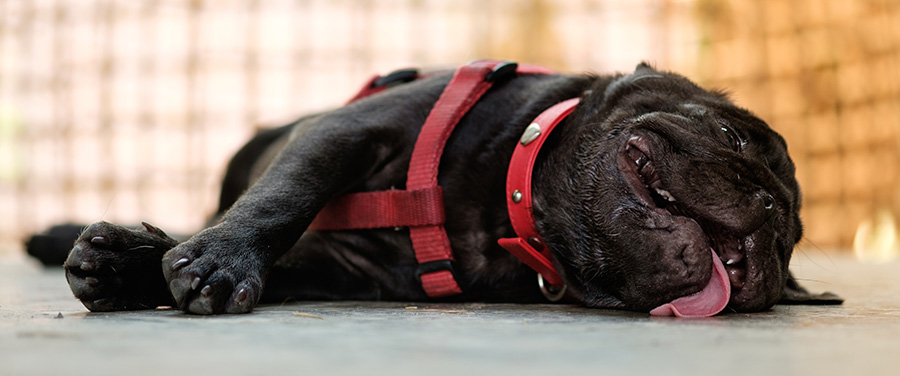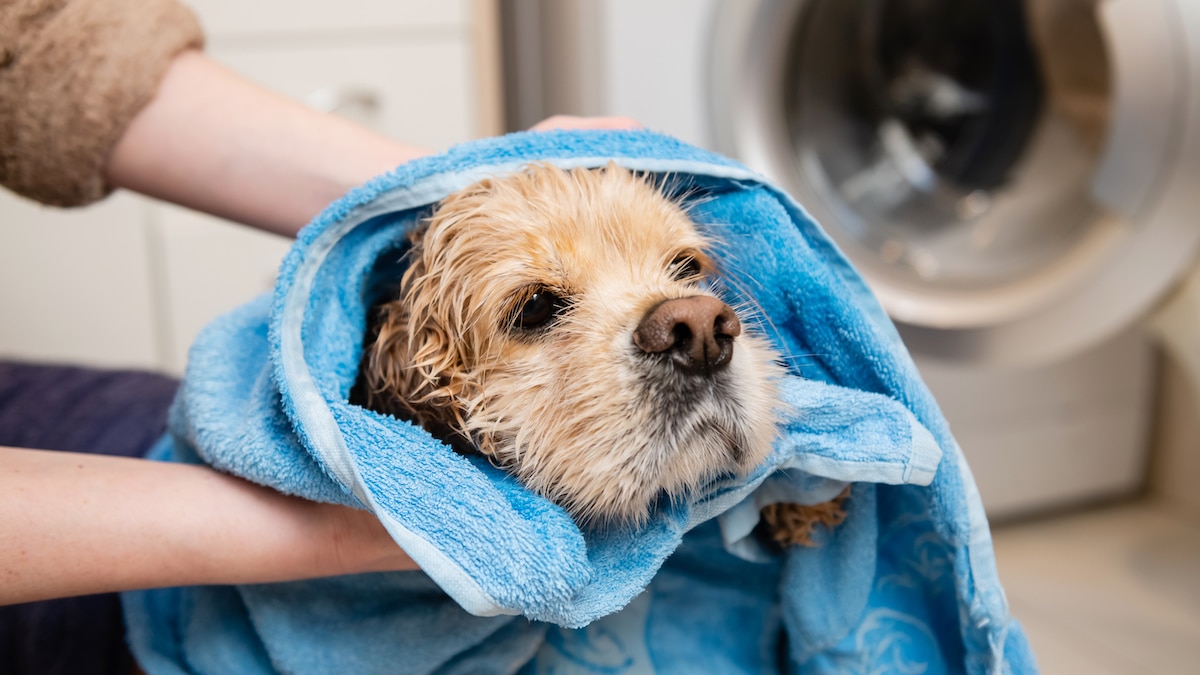Dogs, like humans, are vulnerable to heat stroke, especially during the warmer months. As temperatures rise, dogs are at greater risk of overheating, a condition that can quickly become life-threatening if not treated immediately. Understanding the symptoms of heat stroke and knowing the appropriate first aid methods can save your dog’s life. In this article, we’ll explore the signs of heat stroke, what to do if your dog shows these symptoms, and how you can prevent heat stroke from occurring in the first place.

What Is Heat Stroke in Dogs?
Before diving into the symptoms, it’s crucial to understand what heat stroke is. Heat stroke occurs when a dog’s body temperature rises above the normal range, typically exceeding 103°F (39.4°C). Unlike humans, dogs don’t sweat to cool down; they rely on panting to regulate their body temperature. However, when exposed to high heat, humidity, or excessive exercise, this cooling mechanism may fail, leading to a dangerous increase in body temperature. Left untreated, heat stroke can cause damage to vital organs and may even be fatal. Recognizing the underlying causes of heat stroke can help dog owners be more vigilant during hot weather and ensure their dogs stay safe.
Certain factors increase the risk of heat stroke in dogs. Brachycephalic breeds, such as Bulldogs and Pugs, are particularly susceptible due to their shortened airways, which make it harder for them to breathe and cool down efficiently. Similarly, older dogs, overweight dogs, and those with thick coats are at greater risk. Environmental factors, like being left in a hot car or engaging in vigorous play during peak heat, can also lead to overheating. Understanding these risks is key to preventing a crisis.
Symptoms of Heat Stroke in Dogs
Identifying the early signs of heat stroke is the first step in preventing it from escalating. One of the most noticeable symptoms is excessive panting. While panting is normal for dogs, persistent and heavy panting in warm conditions should be taken seriously. Along with panting, you may observe other physical signs such as drooling, pale or red gums, and a bright red tongue. These symptoms indicate that the dog’s body is working hard to release excess heat but is struggling to do so.

As the condition progresses, more serious symptoms begin to emerge. Dogs may become lethargic, weak, and disoriented. If your dog starts stumbling, seems confused, or has difficulty standing, it is likely that their body temperature has reached a critical point. Rapid heart rate, vomiting, and diarrhea are other alarming signs that the dog is in distress. At this stage, it’s crucial to intervene immediately, as the situation can deteriorate quickly.
In severe cases of heat stroke, the symptoms can become life-threatening. Seizures, unconsciousness, and a lack of coordination are indicators that the dog is experiencing extreme heat stress. Some dogs may also show signs of dark urine or may not urinate at all, a clear signal of dehydration and potential kidney failure. If these symptoms appear, immediate action is necessary to prevent irreversible damage.
First Aid Methods for Heat Stroke in Dogs
If you suspect your dog is suffering from heat stroke, the first thing to do is to remove them from the hot environment. Move your dog into a cooler, shaded area, preferably indoors where air conditioning is available. Reducing their exposure to heat is the fastest way to begin lowering their body temperature. However, the process of cooling down should be gradual to avoid further complications.
Using lukewarm water, not ice-cold, is the safest way to help your dog cool down. Gently wet their fur with room temperature water or use a damp towel to sponge their body, focusing on areas like the neck, armpits, and groin. Avoid shocking their system with ice water, as this can cause blood vessels to constrict, slowing down the cooling process and potentially leading to further complications.

Offering your dog small amounts of cool water to drink can help them rehydrate, but avoid forcing them to drink if they are disoriented. If possible, use a fan to blow cool air over the dog, which can help speed up the cooling process. Monitoring your dog’s temperature is also important—if you have access to a thermometer, aim to bring their temperature down to around 103°F (39.4°C) before stopping cooling measures.
While these steps can be effective in the early stages of heat stroke, severe cases require immediate veterinary attention. If your dog’s condition does not improve, or if symptoms such as seizures or unconsciousness occur, it’s critical to get them to a vet as soon as possible. The vet may administer intravenous fluids, provide oxygen, and monitor for any potential organ damage that can result from prolonged overheating.
Preventing Heat Stroke in Dogs
While first aid can be life-saving, prevention is always the best strategy. Keeping your dog safe from heat stroke starts with limiting their exposure to extreme temperatures. On hot days, avoid walking or exercising your dog during the hottest part of the day. Early morning or late evening walks are safer and less likely to cause overheating. Additionally, make sure your dog always has access to fresh, cool water and a shaded, well-ventilated area where they can rest.
One of the most dangerous mistakes dog owners can make is leaving their dog in a car, even for a short period. Temperatures inside a parked car can rise rapidly, even with the windows slightly open, creating a deadly environment for dogs. The risk of heat stroke in such situations is extremely high, and it’s best to avoid leaving your dog in a vehicle altogether during hot weather.
Providing cooling products, such as cooling mats, vests, or bandanas, can also help keep your dog comfortable in the heat. These products are designed to help dogs regulate their body temperature, particularly during outdoor activities. Grooming your dog regularly, especially if they have a thick coat, can also reduce the likelihood of overheating by allowing better air circulation to their skin.
Special Considerations for Vulnerable Dogs
Certain dogs are more susceptible to heat stroke than others, so additional care is needed for these breeds and individuals. Brachycephalic dogs, such as French Bulldogs and Shih Tzus, have more difficulty regulating their body temperature due to their short snouts and should be carefully monitored during warm weather. Older dogs and those with underlying health issues are also more prone to heat stroke and may require shorter, less intense exercise routines in the heat.
Dogs with thick or double coats, such as Huskies and Golden Retrievers, may overheat faster in warm climates. Regular grooming, including trimming excessive fur, can help keep these dogs cooler. For overweight dogs, heat can be even more dangerous, as their bodies already work harder to carry excess weight. A combination of proper diet, exercise, and careful monitoring can help protect these dogs from overheating.
Heat stroke in dogs is a serious condition that can lead to severe health issues or death if not addressed promptly. Recognizing the symptoms, acting quickly with first aid, and seeking veterinary care when needed can make all the difference. Prevention is key, so taking proactive steps like limiting heat exposure, offering plenty of water, and ensuring proper grooming can significantly reduce the risk of heat stroke.
With a little extra care and vigilance, you can keep your dog safe, cool, and healthy during the hot summer months, ensuring they enjoy the outdoors without the risk of overheating.

After 5 years in a high pace business management role, I partnered with an e-commerce developer to start building Dog Supplies Warehouse.
Our number one goal is to make sure all products are managed and delivered to our customers door fast and accurately.
